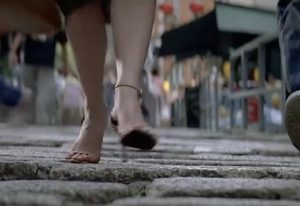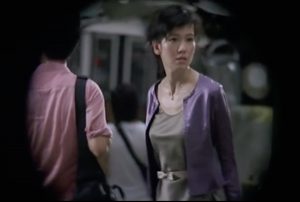SPARROW, DIR. JOHNNIE TO (2008)
Pottinger Street, Central, Mid-Levels District, Hong Kong
The film tells a story about a group of pickpockets. One day, when Kei, the protagonist of the film and the leader of the pickpocket group, was casually taking street photos with his vintage Rolleiflex, a stunning lady suddenly appears through the camera lens as he captured this unpredictable moment right away. After that, every member of the pickpocket group had an encounter with that lady as she requested them for help using their skillsets. It was later revealed that the pickpocket group was lured into a trap and they must unite together in order to defeat the ‘King of Pickpockets’. This movie features a number of streets across Central, Sheung Wan, Wan Chai, and many more places to present the multifaceted and captivating indigenous culture. Many of those shots also successfully resembled the historical and cultural richness of old Hong Kong.
Pottinger Street, also known as Stone Slab Street, is the site where the protagonist captured the image of a young lady, her eyes glancing back towards the lens. In the film, hawker stores with corrugated sheets of iron piled on ceilings were aligned on both sides of the street, adding a bit of rustiness and texture to the scene. In reality, the hawker stores create an ambiance very similar to that of the film: the street filled with hustle and bustle as hawkers raised their voices and peddled their goods. The street presented on the screen, however, has a slightly warmer and more yellowish tone than reality. This color representation can further highlight the unique vibe of vintage Hong Kong during the 70s to 90s period and the historical value of Pottinger Street itself.

1. Hawker stores located in Pottinger Street
Nevertheless, the main focus of that particular scene occurring on Pottinger Street is the young lady dressed in purple, instead of the street surroundings. To do so, the lady was seen through the convex lens of the Rolleiflex owned by the protagonist. As a result, the focus was enlarged and the surroundings, including hawker stores and passers-by, were shrunken. Besides, in an attempt to show that the lady was in a hurry during her encounter with the protagonist, for a few seconds, the camera zoomed into the uneven stone slabs, which are one of the major characteristics of Pottinger Street. Meanwhile, the walking pace of pedestrians at that time instantly slowed down. Everything seemed to be in slow-motion except for the lady herself. Given that the lady was clumsily running on such a bumpy slope with high heels on, by presenting the details of the street, the film successfully conveys the emotion of characters into motion pictures, with the aid of filming angles, architectural representation, and adequate environmental description.


2. Public pavilion situated in Pottinger Street. This is the site where the protagonist had set up his Rolleiflex
3. Lady in the film running on the stone slabs with high heels on (video link: course.arch.hku.hk/…/RPReplay_Final1615623227.mov)
Overall, Sparrow is an aesthetic film and explains things in a very artistic way. Showing the urban hyperdensity and cultural richness of Hong Kong, the film sacrificed a fast-paced plot and character progression and instead put emphasis on filming picturesque sceneries, streets and details. The excellent cinematography of this film is not solely about highlighting local architecture and collective memories, but it also represents a sense of human touch unique to Hong Kong.
— Ng Terence 3035791696

4. Lady seen under the lens of the protagonist’s Rolleiflex
You summarised the film, Sparrow, very well. I would suggest using one of the key concepts we have discussed in the class to help you build your argument. This concept will provide you with an analytical lens to read your site through. That way, you can build an even stronger argument or position. Focusing on the space, comparing how it is portrayed, or utilised (both in the film and in reality) would give your essay more depth as well. In your essay, you pointed out the role of film in conveying certain architectural representation through descriptive narrative. To better elaborate on this take, you could expand on what kind of architectural representation and exactly what is portrayed in the film. By comparing the real condition to the “reality” portrayed in the film, you could also build your argument on the idea of identity and representation. In what way had the film showed the urban hyperdensity? Taking the film’s storyline into account, how would you think this hyperdensity add up to the whole narrative of Sparrow? Lastly, remember to put a proper reference to your writing. The citation must be incorporated in the essay, both for cited text and images which are not yours.